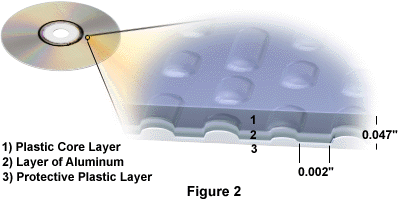Slide 4.12: DVDs (Digital Versatile Discs)
Home

|
Slide 4.10: The cost of magnetic-tape accesses Slide 4.12: DVDs (Digital Versatile Discs) Home |

|

|
A 4.72 inch disc can store still and/or moving images in monochrome and/or color; stereo or two separate sound tracks integrated with and/or separate from the images; and digital program and information files. There are three kinds of CDs: |
| The figure shows a cross section of a compact disc. It is built from a layer of polycarbonate plastic, covered in a color-dyed layer of aluminum, and followed by a protective layer of lacquer. |

|